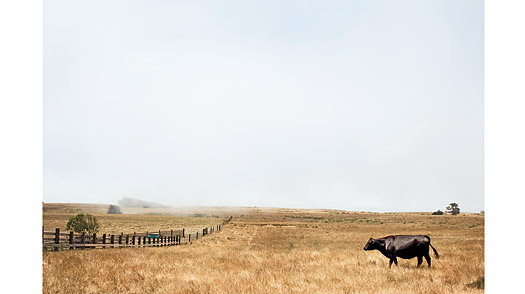
One of more than 100 cattle on Bill Niman's California property, home of an ongoing experiment in sustainable ranching.
(2 of 8)
Some Americans are heeding such warnings and working to transform the way the country eats--ranchers and farmers who are raising sustainable food in ways that don't bankrupt the earth. Documentaries like the scathing Food Inc. and the work of investigative journalists like Eric Schlosser and Michael Pollan are reprising Sinclair's work, awakening a sleeping public to the uncomfortable realities of how we eat. Change is also coming from the very top. First Lady Michelle Obama's White House garden has so far yielded more than 225 lb. of organic produce--and tons of powerful symbolism. But hers is still a losing battle. Despite increasing public awareness, sustainable agriculture, while the fastest-growing sector of the food industry, remains a tiny enterprise: according to the most recent data from the U.S. Department of Agriculture (USDA), less than 1% of American cropland is farmed organically. Sustainable food is also pricier than conventional food and harder to find. And while large companies like General Mills have opened organic divisions, purists worry that the very definition of sustainability will be co-opted as a result.
But we don't have the luxury of philosophizing about food. With the exhaustion of the soil, the impact of global warming and the inevitably rising price of oil--which will affect everything from fertilizer to supermarket electricity bills--our industrial style of food production will end sooner or later. As the developing world grows richer, hundreds of millions of people will want to shift to the same calorie-heavy, protein-rich diet that has made Americans so unhealthy--demand for meat and poultry worldwide is set to rise 25% by 2015--but the earth can no longer deliver. Unless Americans radically rethink the way they grow and consume food, they face a future of eroded farmland, hollowed-out countryside, scarier germs, higher health costs--and bland taste. Sustainable food has an élitist reputation, but each of us depends on the soil, animals and plants--and as every farmer knows, if you don't take care of your land, it can't take care of you.
The Downside of Cheap
For all the grumbling you do about your weekly grocery bill, the fact is you've never had it so good, at least in terms of what you pay for every calorie you eat. According to the USDA, Americans spend less than 10% of their incomes on food, down from 18% in 1966. Those savings begin with the remarkable success of one crop: corn. Corn is king on the American farm, with production passing 12 billion bu. annually, up from 4 billion bu. as recently as 1970. When we eat a cheeseburger, a Chicken McNugget, or drink soda, we're eating the corn that grows on vast, monocrop fields in Midwestern states like Iowa.
